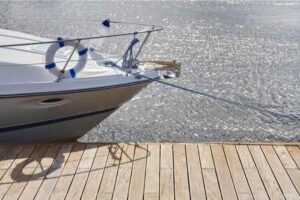
Watercraft insurance for inland waterways is an essential safeguard for boat owners navigating rivers and lakes. This coverage not only protects your investment but also ensures peace of mind while enjoying the great outdoors, knowing that you’re financially backed in case of unforeseen incidents.
From recreational canoes to motorized vessels, understanding the types of watercraft covered and the factors influencing insurance premiums is crucial for making informed decisions. This guide delves into the nuances of watercraft insurance, providing clarity on types of policies, benefits, and common misconceptions, ensuring that you can sail smoothly on your water adventures.
Watercraft Insurance Overview

Watercraft insurance is essential for anyone operating a vessel on inland waterways. Just like auto insurance, it protects you against potential liabilities and damages that may arise while navigating rivers, lakes, and canals. This coverage not only secures your financial investment but also ensures compliance with local regulations, which often mandate insurance for watercraft.Different types of watercraft are covered under inland waterway insurance policies.
These may include motorboats, sailboats, personal watercraft (like jet skis), and even houseboats. Each type has its own specific requirements and coverage options tailored to its unique characteristics and risks. Understanding these distinctions is crucial for selecting the right insurance that meets your needs.
Factors Affecting Watercraft Insurance Premiums
Several key factors influence the premiums associated with watercraft insurance. Being aware of these variables can help you make informed decisions and possibly reduce your insurance costs. The following points Artikel the primary considerations that insurers evaluate when determining your premium:
- Type of Watercraft: The make, model, and age of your watercraft play a significant role in premium calculations. Newer and more valuable vessels generally incur higher premiums.
- Usage: How often and for what purpose you use your watercraft impacts the premium. Frequent recreational use may lead to higher costs compared to occasional use.
- Location: The geographic area where you operate your watercraft affects risk levels. Insurers consider factors such as waterway conditions and crime rates in the vicinity.
- Experience: Your experience and boating safety record are crucial. A history of accidents or claims can increase your premium, whereas a clean record may lead to discounts.
- Coverage Levels: The amount and type of coverage you select influence your premium. Higher liability limits and comprehensive coverage options typically come with increased costs.
Understanding these factors allows watercraft owners to better navigate their insurance options and possibly save on premiums.
Comparisons and Benefits
Watercraft insurance is a specialized coverage that protects your watercraft from various risks, similar to other types of insurance like pet insurance and travel insurance. Understanding how these insurances differ can help you appreciate the value of watercraft insurance and its unique benefits. While pet insurance covers veterinary costs for your furry companions, and travel insurance protects you against losses incurred during trips, watercraft insurance focuses specifically on safeguarding your investment on the water.
Each type of insurance serves its purpose, but the specific threats faced by watercraft owners, such as damage from collisions, storms, or theft, require tailored coverage.
Benefits of Supplemental Insurance
Supplemental insurance can greatly enhance the protection you get from your watercraft insurance policy. These additional policies cover gaps that might not be addressed by your primary watercraft insurance. Having a supplemental policy can provide financial security in unexpected situations. For instance, if your watercraft is involved in an accident that exceeds your primary policy’s limits, supplemental insurance can help cover the remaining costs.
This is especially important for high-value watercraft, where the financial stakes are significantly higher. Here are some benefits to consider:
- Coverage for specialized risks, such as environmental damage or liability claims.
- Extended protection for personal belongings on board, which might not be covered under standard policies.
- Peace of mind knowing that you are financially protected from potential out-of-pocket expenses.
Common Misconceptions About Watercraft Insurance
Despite its importance, there are several misconceptions surrounding watercraft insurance that can lead to confusion among boat owners. Addressing these misconceptions helps clarify what watercraft insurance truly offers. Many believe that watercraft insurance is not necessary if they don’t use their watercraft frequently. In reality, even occasional use can lead to unexpected events that could result in significant financial loss.
Additionally, some think their homeowners’ insurance automatically covers watercraft; however, most policies have limitations on coverage for watercraft, particularly for liabilities incurred while operating the vessel. Here’s a list of common misconceptions about watercraft insurance:
- Watercraft insurance is only for new or expensive watercraft; even older models can benefit from coverage.
- Homeowner’s insurance fully covers watercraft damages; this is usually not the case.
- Liability coverage is not necessary if you are a careful operator; accidents can happen regardless of skill.
Policy Features and Considerations
When navigating the waters of watercraft insurance, understanding the specific features of various policies can make a significant difference in your coverage choice. Policies can vary widely in terms of coverage limits, deductibles, and exclusions, which are crucial elements to consider before making a decision. This section delves into the common features found in watercraft insurance policies, providing clarity on what you can expect.
Common Features of Watercraft Insurance Policies
Watercraft insurance policies typically include several key features designed to protect the policyholder against various risks associated with owning and operating a watercraft. Knowing these features can help you choose the appropriate coverage for your needs.
- Liability Coverage: This is essential coverage that protects you if you are held responsible for damages or injuries to others while operating your watercraft.
- Collision Coverage: This provides financial protection for damages to your watercraft resulting from a collision with another object, such as another boat or a dock.
- Comprehensive Coverage: This covers damages to your watercraft from non-collision incidents, such as theft, vandalism, or natural disasters.
- Medical Payments Coverage: This feature helps cover medical expenses for you and your passengers in the event of an accident, regardless of who is at fault.
- Uninsured/Underinsured Boater Coverage: This protects you if you are involved in an accident with a boater who does not have adequate insurance.
Comparison of Coverage Limits, Deductibles, and Exclusions
Understanding the differences between policies can help you tailor your coverage to meet your specific needs. Below is a comparison table that Artikels various coverage limits, deductibles, and exclusions for different watercraft insurance policies.
| Policy Type | Coverage Limit | Deductible | Common Exclusions |
|---|---|---|---|
| Basic Liability | $100,000 per incident | $500 | Negligence, racing incidents |
| Comprehensive & Collision | $300,000 per incident | $1,000 | Wear and tear, intentional damage |
| Medical Payments | $50,000 | $0 | Non-passenger injuries, pre-existing conditions |
| Uninsured Boater | $200,000 | $1,000 | Accidents involving personal watercraft |
Importance of Umbrella Insurance in Relation to Watercraft Insurance
Umbrella insurance serves as an additional layer of protection that extends beyond the standard limits of your watercraft insurance policy. It’s particularly important for individuals who own valuable assets or engage in high-risk activities, as it can safeguard against significant financial losses not covered by primary insurance.
“Umbrella insurance can provide peace of mind by covering large claims or lawsuits that may exceed the limits of your watercraft policy.”
This type of insurance can help cover legal fees, damages, and settlements in a variety of scenarios, ensuring that your financial future remains secure even in the event of a substantial claim. If you frequently navigate busy waterways or host events on your watercraft, considering umbrella insurance can be a wise move.
Conclusive Thoughts

In summary, securing watercraft insurance for inland waterways is a wise decision for any boat enthusiast. By understanding the various types of coverage, the benefits of supplemental insurance, and the features of different policies, you can make informed choices that enhance your boating experience. With the right protection, you can focus on what truly matters—enjoying your time on the water.
FAQ Compilation
What is the average cost of watercraft insurance?
The average cost varies based on factors like the type of watercraft, coverage limits, and the owner’s claims history, typically ranging from $200 to $500 annually.
Do I need watercraft insurance if I have a boat trailer?
Yes, insurance for your boat usually covers the trailer as well, but it’s essential to confirm with your provider to ensure comprehensive coverage.
Can I get coverage for renting a watercraft?
Many insurers offer policies that include coverage for renting watercraft, but it’s advisable to check specific terms and conditions with your insurance provider.
What should I do if I have a claim?
You should contact your insurance provider as soon as possible, providing all necessary information and documentation regarding the incident.
Are there exclusions in watercraft insurance policies?
Yes, common exclusions may include damages due to negligence, racing, or using the watercraft for commercial purposes. Always read your policy carefully to understand these details.




